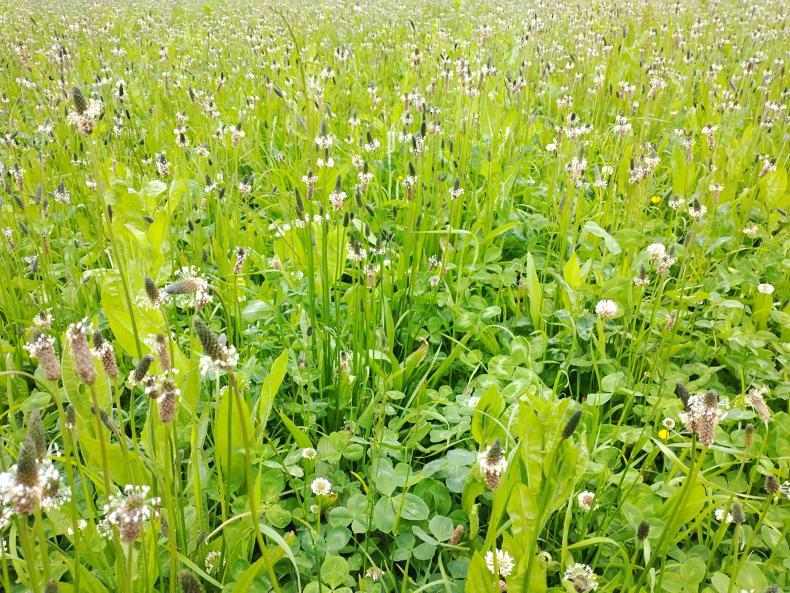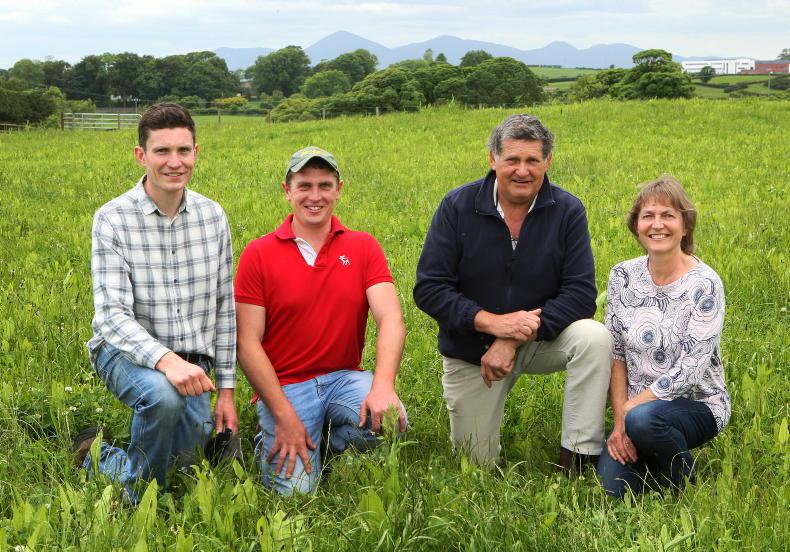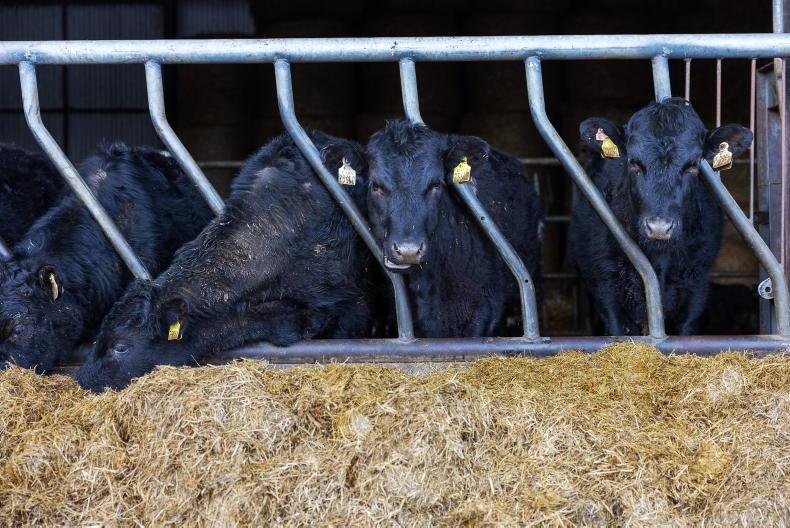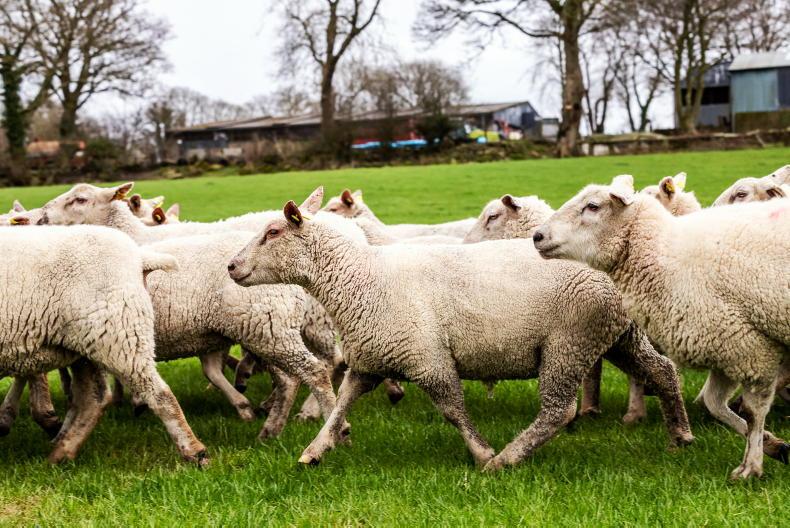Downpatrick beef farmers Paul, Frank and Thomas Turley have experienced a number of different challenges since they established multi-species swards (MSS) across 40 acres in spring 2021.
In general, the Turleys are impressed by how the swards are performing, with growth rates comparable to conventionally managed grass swards, despite the MSS receiving zero nitrogen (N) fertiliser input.
One of six beef and sheep farms taking part in a European Innovation Partnership (EIP) project led by AgriSearch, the Turley farm hosted a farm walk on Monday, attended by several hundred farmers.
Extending to 160ha, the farm is stocked with 180 spring- and 60 autumn-calving Angus cows, with some dairy beef calves also brought in for finishing. In recent years cows have been crossed to Wagyu bulls as part of supply arrangement with Marks & Spencer through Linden Foods.
There is no housing on the farm, so all cattle are overwintered on brassicas such as kale, supplemented with grass silage. It means all swards are put into brassicas every five to six years. The 40 acres of MSS came out of kale in the spring of 2021.
Moisture
Having established the MSS in 2021, the farm was hit by a prolonged dry spell. “It looked like a mess. But when the rain came, it changed completely. It needs moisture to get going,” said Paul Turley.
The clover and herbs in the MSS tend to be very small seeds, so they must not be buried too deeply. They also like a firm seed bed, so the field should be rolled, sowed and rolled again.

A multispecies sward ready for grazing on the Turley farm outside Downpatrick.
“There is nothing you can do about weeds, so you need to be working in advance of sowing,” said Paul. On some of the EIP farms a “stale seed bed” method is used, where the sward is burned off, ploughed, cultivated, left for 10 to 14 days for any weeds to germinate, and then sprayed again.
In terms of soil nutrients, pH should be at least 6.5, and phosphorus and potassium indices at 2+ and above. MSS is not suited to poorly drained land.
Manage the MSS
Once in place, the next key issue is how to manage the MSS. “One of the biggest problems is the change of mindset,” acknowledged Paul.
He said that post-grazing it can look “untidy”, and that they have probably been holding cattle slightly too long in paddocks trying to force them to clean out the sward. Paddocks are being topped after their third grazing, and at present the Turleys do not intend topping again.
“We have got used to it and learned to respect it for what it is. What we leave behind after each grazing isn’t waste – it feeds the soil biology,” said Paul.
Drought
The farm is dry, with the first MSS paddocks grazed on 1 February. But with dry land comes the threat of drought, and after 1o consecutive days of no rain, growth noticeably slows.
However, unlike the last two years, drought has not been an issue so far in 2022, so it is hard to quantify the extent to which the MSS on the farm can mitigate against dry conditions. Among the various MSS established on the Turley farm is a mix specifically designed to be drought tolerant, with perennial ryegrass replaced by deep-rooting cocksfoot, timothy and meadow fescue.
Mixes
Other paddocks have been sown out without any grass (red and white clover, plus plantain), a standard six-species mix (perennial ryegrass, timothy, red and white clover, plantain and chicory) and an 18-species mix that includes a number of annual plants.
“The 18-species sward was absolutely alive with insects last July. I had never seen anything like it before. There is no added advantage from a production point of view, but there is an advantage in biodiversity,” suggested Paul.
He said that chicory tends to be significantly less persistent than plantain, while white clover will outlast red clover.
“My advice to any farmer is to try a six-species sward. If you tramp it or make mistakes and it dies out, you are still left with an excellent sward of grass and clover,” said Paul.
Cost of the MSS mix is generally around 15% to 20% more than a standard bag of grass seed.
Lower weight gains on MSS in 2022
Paul and Frank Turley have 100 wagyu-cross calves split into two groups, one of which is exclusively grazing across MSS, with the other on grass only swards. Both grazing areas are stocked at 500kg liveweight per acre.
From 21 March to 31 May 2022, the group on the MSS have gained 0.71kg/day, with the grass-only group at 0.82kg/day, a 15% difference.

The batch of Wagyu cross cattle grazing across the MSS on the Turley farm.
“The cattle on the MSS have underperformed,” said Paul, although he believes the main issue is they have been forcing cattle to clean out paddocks. “That was a mistake and we are now moving them quicker. Our expectation is that performance will catch up,” he added.
Among the other reported benefits of MSS is their anthelmintic properties, meaning lower worm burdens in grazing livestock. As the year progresses, this may help support higher weight gains on MSS.
It is worth noting that the growth of perennial ryegrass tends to dip during the summer, while clover and herbs are likely to remain relatively steady.
But one main difference when grazing MSS is the need for a 30-day rotation, rather than a 21-day rotation with grass.
“The MSS sits to 20 days, and then does a lot to 30 days,” said Paul.
Red clover silage a
‘no-brainer’
In addition to the MSS, the Turleys also grow a red clover grass mix without any N fertiliser, and have established a further 17 acres in 2022.
“To me it’s a bit of a no-brainer. Why not move to red clover silage? The big incentive is zero N,” said AFBI researcher Dr David Patterson.
He maintained that the clover should last two to four years, and deliver good yields, along with 1% to 2% higher protein content than conventional grass silage.
But he accepted that the crop “is not faultless”, and as the clover has an elevated growing point it cannot be cut too close to the ground, and is susceptible to traffic.
His advice is that July and into early August is the ideal time to establish a sward. It should receive “one sharp grazing” before closing up for the winter.
MSS for silage
It is also possible to ensile a MSS for silage, but as herbs and legumes tend to hold more moisture than grass, a 48-hour wilt may be necessary.
Read more
Watch: my experience with a multi-species sward
Spring reseed best for multispecies swards
Downpatrick beef farmers Paul, Frank and Thomas Turley have experienced a number of different challenges since they established multi-species swards (MSS) across 40 acres in spring 2021.
In general, the Turleys are impressed by how the swards are performing, with growth rates comparable to conventionally managed grass swards, despite the MSS receiving zero nitrogen (N) fertiliser input.
One of six beef and sheep farms taking part in a European Innovation Partnership (EIP) project led by AgriSearch, the Turley farm hosted a farm walk on Monday, attended by several hundred farmers.
Extending to 160ha, the farm is stocked with 180 spring- and 60 autumn-calving Angus cows, with some dairy beef calves also brought in for finishing. In recent years cows have been crossed to Wagyu bulls as part of supply arrangement with Marks & Spencer through Linden Foods.
There is no housing on the farm, so all cattle are overwintered on brassicas such as kale, supplemented with grass silage. It means all swards are put into brassicas every five to six years. The 40 acres of MSS came out of kale in the spring of 2021.
Moisture
Having established the MSS in 2021, the farm was hit by a prolonged dry spell. “It looked like a mess. But when the rain came, it changed completely. It needs moisture to get going,” said Paul Turley.
The clover and herbs in the MSS tend to be very small seeds, so they must not be buried too deeply. They also like a firm seed bed, so the field should be rolled, sowed and rolled again.

A multispecies sward ready for grazing on the Turley farm outside Downpatrick.
“There is nothing you can do about weeds, so you need to be working in advance of sowing,” said Paul. On some of the EIP farms a “stale seed bed” method is used, where the sward is burned off, ploughed, cultivated, left for 10 to 14 days for any weeds to germinate, and then sprayed again.
In terms of soil nutrients, pH should be at least 6.5, and phosphorus and potassium indices at 2+ and above. MSS is not suited to poorly drained land.
Manage the MSS
Once in place, the next key issue is how to manage the MSS. “One of the biggest problems is the change of mindset,” acknowledged Paul.
He said that post-grazing it can look “untidy”, and that they have probably been holding cattle slightly too long in paddocks trying to force them to clean out the sward. Paddocks are being topped after their third grazing, and at present the Turleys do not intend topping again.
“We have got used to it and learned to respect it for what it is. What we leave behind after each grazing isn’t waste – it feeds the soil biology,” said Paul.
Drought
The farm is dry, with the first MSS paddocks grazed on 1 February. But with dry land comes the threat of drought, and after 1o consecutive days of no rain, growth noticeably slows.
However, unlike the last two years, drought has not been an issue so far in 2022, so it is hard to quantify the extent to which the MSS on the farm can mitigate against dry conditions. Among the various MSS established on the Turley farm is a mix specifically designed to be drought tolerant, with perennial ryegrass replaced by deep-rooting cocksfoot, timothy and meadow fescue.
Mixes
Other paddocks have been sown out without any grass (red and white clover, plus plantain), a standard six-species mix (perennial ryegrass, timothy, red and white clover, plantain and chicory) and an 18-species mix that includes a number of annual plants.
“The 18-species sward was absolutely alive with insects last July. I had never seen anything like it before. There is no added advantage from a production point of view, but there is an advantage in biodiversity,” suggested Paul.
He said that chicory tends to be significantly less persistent than plantain, while white clover will outlast red clover.
“My advice to any farmer is to try a six-species sward. If you tramp it or make mistakes and it dies out, you are still left with an excellent sward of grass and clover,” said Paul.
Cost of the MSS mix is generally around 15% to 20% more than a standard bag of grass seed.
Lower weight gains on MSS in 2022
Paul and Frank Turley have 100 wagyu-cross calves split into two groups, one of which is exclusively grazing across MSS, with the other on grass only swards. Both grazing areas are stocked at 500kg liveweight per acre.
From 21 March to 31 May 2022, the group on the MSS have gained 0.71kg/day, with the grass-only group at 0.82kg/day, a 15% difference.

The batch of Wagyu cross cattle grazing across the MSS on the Turley farm.
“The cattle on the MSS have underperformed,” said Paul, although he believes the main issue is they have been forcing cattle to clean out paddocks. “That was a mistake and we are now moving them quicker. Our expectation is that performance will catch up,” he added.
Among the other reported benefits of MSS is their anthelmintic properties, meaning lower worm burdens in grazing livestock. As the year progresses, this may help support higher weight gains on MSS.
It is worth noting that the growth of perennial ryegrass tends to dip during the summer, while clover and herbs are likely to remain relatively steady.
But one main difference when grazing MSS is the need for a 30-day rotation, rather than a 21-day rotation with grass.
“The MSS sits to 20 days, and then does a lot to 30 days,” said Paul.
Red clover silage a
‘no-brainer’
In addition to the MSS, the Turleys also grow a red clover grass mix without any N fertiliser, and have established a further 17 acres in 2022.
“To me it’s a bit of a no-brainer. Why not move to red clover silage? The big incentive is zero N,” said AFBI researcher Dr David Patterson.
He maintained that the clover should last two to four years, and deliver good yields, along with 1% to 2% higher protein content than conventional grass silage.
But he accepted that the crop “is not faultless”, and as the clover has an elevated growing point it cannot be cut too close to the ground, and is susceptible to traffic.
His advice is that July and into early August is the ideal time to establish a sward. It should receive “one sharp grazing” before closing up for the winter.
MSS for silage
It is also possible to ensile a MSS for silage, but as herbs and legumes tend to hold more moisture than grass, a 48-hour wilt may be necessary.
Read more
Watch: my experience with a multi-species sward
Spring reseed best for multispecies swards












SHARING OPTIONS